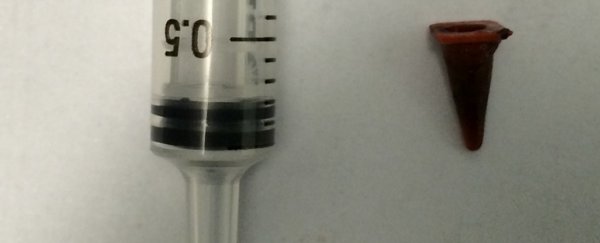A 47-year-old man in the UK has received what might be the best news possible - that a suspected case of lung cancer was not lung cancer at all, but a Playmobil traffic cone he inhaled as a child.
The man was referred to a respiratory clinic after a year of dealing with symptoms. He was coughing and producing mucus, even after being treated for pneumonia (which did, to be fair, result in a slight improvement).
When doctors X-rayed the patient's lungs, they found a mass in his right lung that significantly reduced the organ's volume. It looked like a malignant tumour - but, on performing a bronchoscopy, instead they found a foreign object lodged in his lung, and removed it with forceps.
Closer inspection revealed that it was, indeed, a plastic toy traffic cone.
"Following the procedure, the patient reported that he regularly played with and even swallowed pieces of Playmobil during his childhood," the team writes in the case study.
"He recalled being given this Playmobil set for his seventh birthday and believes he aspirated the toy traffic cone soon after."
Children inhale small toys relatively frequently, but it's rare for it to go more than a week without being diagnosed. For a case to go 40 years before any symptoms appear is "unheard of" in literature, the doctors said.
It's possible that, because the patient was so young when he inhaled the cone, his airway was able to adapt around it, absorbing it into the mucosal lining. As the patient started smoking, any symptoms may have been masked by the symptoms of smoking.
 Denny et al./BMJ Case Reports
Denny et al./BMJ Case Reports
Four months after the object was removed, the patient's persistent cough had cleared up, and the consolidation of his lung tissue had mostly subsided. There is some permanent enlargement of the airways, but this occurs in about 20 percent of patients with a chronic foreign body in their lungs.
"On a positive note," the doctors wrote, "his symptoms improved markedly and he finally found his long lost Playmobil traffic cone in the very last place he would look."
The paper has been published in the journal Biomedical Journal Case Reports.
